
by Alova
© 2010, published in ISAR International Astrologer, Leo 2010
Posted with permission. This article may be printed out for personal, non-commercial use only.
Abstract: The problem of defining astrological house cusps at polar latitudes is reviewed. A simple solution is proposed. The resulting house system can be used at all latitudes, has house cusps extremely close to Placidus cusps up to 60° latitude, has no jumps in house cusps, and reflects the type of day we experience at polar latitudes.
In ISAR International Astrologer, Sagittarius 2009, “An Astrological Dilemma: Polar Latitudes”(1) describes what happens when we attempt to construct horoscopes for latitudes above the Arctic Circles, where most house systems are completely undefined. Cases are shown where the traditionally-defined Ascendant or Descendant are actually conjunct the Midheaven and there are only two, four, or six houses in the horoscope. For some period of the day, the traditional Ascendant moves backward through the zodiac.(2)(3) What are we to do with our house cusps at these times? They work so well at lower latitudes.
We need a solution—and we need one that works astrologically. We should be able to construct astrological charts for anywhere on the Earth, using a wconsistent method—not abruptly switching calculation method when our preferred method breaks down, as most astrology programs do (without informing you).
What if you took a summer cruise to see the Northern Lights, and you wanted to schedule a celebration at a favorable time? What if an explorer consulted you to choose good dates for a dangerous polar expedition? What about researching meteorological events at the weather station in Alert, Canada? How would you feel being left completely out of Astrology just because of where you were born?
For a solution to this problem we must either discard the Ascendant or Midheaven as house cusps, or adjust our definition of the Ascendant or Midheaven, as explained in previous issues.(1)(3) Since the traditional Ascendant and Midheaven have both been shown by arduous research on tens of thousands of charts to be coordinated with actual characteristics of real people, it would be improper to discard either one of them completely.
The Ascendant is traditionally defined as the intersection of the Eastern side of the Horizon with the Earth-Sun (Ecliptic) plane. Since the Sun is always in the Ecliptic plane, this definition is based upon the path of the Sun from our viewpoint on Earth. Up to temperate latitudes, Sunrise to Sunset corresponds to our diurnal rhythm, getting up in the morning and going to bed at night. This definition is quite natural because at most latitudes, the Sun does rise and set every day, and so this definition models a 24-hour day, one spin of the Earth. However, as pointed out in the above-mentioned articles, at the North Pole it is one full year from one Sunrise to the next! If the Sun does not rise or does not set for days, people still get up and retire every day, and this diurnal rhythm should be reflected in a horoscope. The appropriate cycle on which to model a house system is not Sunrise-to-Sunrise (as with most traditional house systems), but rather one 24-hour day, one spin of the Earth on its axis.
Up to the Arctic Circles, all degrees of the zodiac rise and set once each day. At higher tropical latitudes, some sections of the zodiac are of “fast ascension” and others are of “slow ascension,” but all degrees do rise and set. (See Figure 1) The East Point is at the center of the circles in Figure 1, pointing out of the page. Notice that if we are at the Equator, the Ascendant (a point along the thick line, depending on the time of day) is quite close to the East Point, and if we are at the Arctic Circle, the Ascendant can be very far from the East Point. At high latitudes in summer and winter, the Sun rises from Northeast or Southeast, far from due East.
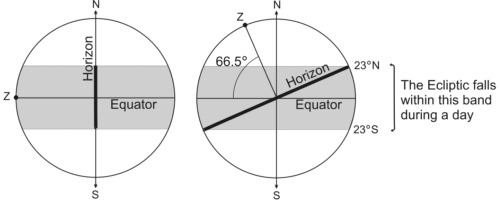
Figure 1 Up to the Arctic Circles, the Horizon Intersects the EntireEcliptic
At polar latitudes, however, some degrees of the zodiac never rise or set. (See Figure 2.)
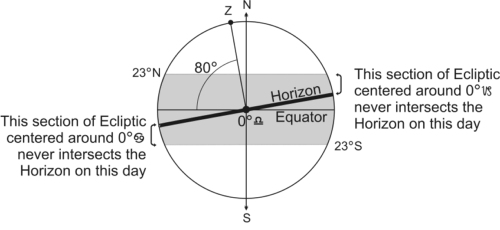
Figure 2 Some Sections of the Ecliptic Cannot Rise on Some Days
At extreme latitudes, Sunrise to Sunset can actually take up to 6½ months. A 24-hour diurnal rhythm does not correspond to Sunrise-to-Sunset in the Arctics. It is at these times that our astrological horoscopes fail utterly. For this reason, we must change our definition of the Ascendant in order to solve the problem of constructing horoscopes at all latitudes.
Our new definition must be identical to the old one at lower latitudes, and, at polar latitudes, it must cycle through the zodiac every24 hours just like it does at lower latitudes. Our new definition must start with one view (our old formula) and, just like progressive bifocal lenses, gradually progress to a new view that makes sense for polar latitudes. The Ascendant should go through the 360° of the zodiac every 24 hours, without skipping, jumping 180°, or turning backwards, at all latitudes up to 89° 59' 59".
As pointed out in a previous International Astrologer article,(4) the intermediate house cusps for Placidus, Koch, and Topocentric house systems are based on both time and space: the Midheaven and Ascendant are defined according to the usual space-geometry formulas, and the intermediate cusps are determined by dividing the time between certain moments of the Sun’s motion above the Horizon. However, at polar latitudes there are times when the Sun doesn’t appear above the Horizon so there are no times to trisect. Thus, the Placidus, Koch, and several other house systems are actually undefined for polar latitudes.
Where can we start? One house system—and only one house system—has a method in place to calculate house cusps at different “poles” (a mathematical term corresponding to latitude). This house system, in fact, views the Earth from our position on its surface—the same view we use when drawing planets in a (geocentric) horoscope wheel. The cusps of this house system are almost identical to Placidus cusps at lower latitudes. This house system is the only one that uses the Ascendant and Midheaven, yet is defined for polar latitudes. It is the Topocentric House System developed by Polich & Page.(3)
However, the Topocentric House System has not yet been refined to meet our requirements outlined above. It uses the traditionally-defined Ascendant up to the Arctic Circle, and then there are two versions of what happens next. According to at least one source,(5) the “pole” of the Ascendant is equal to the latitude up to 66.56° (the traditional definition), and then turns around and approaches zero at 90° latitude(see graph, Figure 3 below). This means that at the North Pole, the Ascendant would coincide with the Equatorial Ascendant (close to the East Point, as in the left diagram in Figure 1).
Why should the Polar Ascendant coincide with the Equatorial Ascendant? They are 90° apart, and one experiences entirely different days at the Equator and at the North Pole. In addition, the abrupt change in the graph at 66.56° results in strange changes in horoscopes from just below to just above the Arctic Circle. It would make more sense for the changes to be gradual and monotonic, like the gradual increase and decline of the Sun in Nature.
At the North and South Poles, the Topocentric Pole of the Ascendant should reflect its extreme, just as its value at the Equator already reflects its minimum. Since the extreme of what we observe in Nature is at the Poles, the maximum zodiacal range of the Ascendant should also occur at the Poles.
Figure 3 depicts a simple modification of the Topocentric House System. Instead ofcalculating the Ascendant as the intersection of the Horizon and Ecliptic atall latitudes (the straight line, which fails), and instead of abruptlychanging our definition of the Ascendant at 66.56° (which also presentsproblems), we calculate our ascendant according to the “Proposed”curve. The formula is quite simple and is given below. Right at the North andSouth Poles, 90° geographical latitude, the pole of the Ascendant is 66.56°.This means that, at the North Pole, the Ascendant is defined as theintersection of the Horizon at 66.56°N with the Ecliptic.Exactly at the North or South Pole, and nowhere else, the Pole of the Ascendantis undefined for one instant per day.
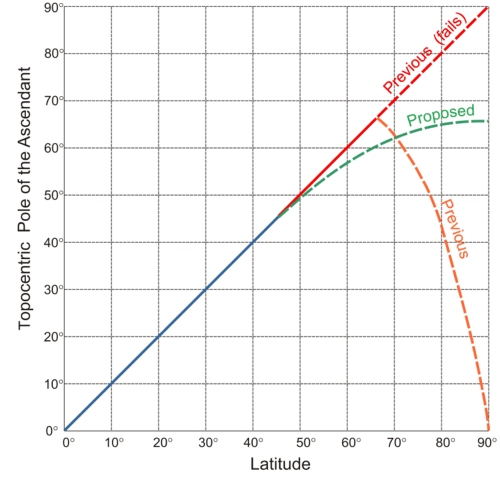
Figure 3 Pole of the Ascendant vs. Latitude
This simple modification in the calculation of the Topocentric Ascendant meets our criteria for a house system that works for all latitudes:
2) The Ascendant moves from its first view to its new view gradually and monotonically as our latitude increases, like Nature, and like “progressive” lenses.
3) All of the “progressive” Topocentric house cusps are identical to the previous Topocentric house cusps for latitudes up to 43°, and extremely close for latitudes up to 60°.
4) In turn, the “progressive” Topocentric house cusps are extremely close to Placidus house cusps, for which there is much hard and even more “soft” evidence.
5) The extremes astrologically (some large houses and some small houses) occur at the times and places of the extremes in Nature.
6) Since Topocentric House cusps are calculated based on the Pole of the Ascendant, calculating the intermediate cusps is quite straightforward, just like before.
This “progressive” Topocentric house system, through its simple modification of the pole of the Ascendant, reflects Nature in the horoscope. It reflects the fact that there is a 24-hour day in which we arise and retire, with or without sunshine or a well-behaved traditionally-defined Ascendant. It reflects that fact that we see half of the horizon at a time, wherever we are. It reflects the fact that the rising and setting of the Sun and planets happen more gradually at polar latitudes, and thus we might experience them slightly differently. It reflects the fact that the planets and stars influence us, even if we don’t see them above the horizon for a long time. And it reflects the fact that human life indeed exists and thrives in polar regions.
The Sirius 1 and Kepler 7 programs already have thisnew “progressive” Topocentric House System as an option.(6) Here are the wheels for Andrey, “Andrea,” and “Andrei” using old and new house systems:(7)
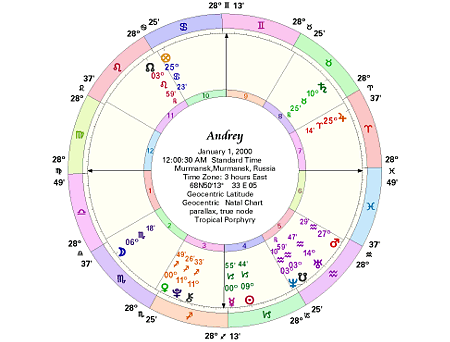
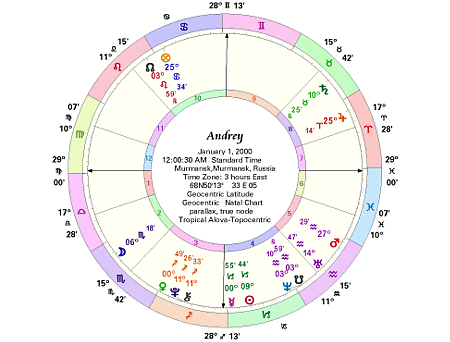
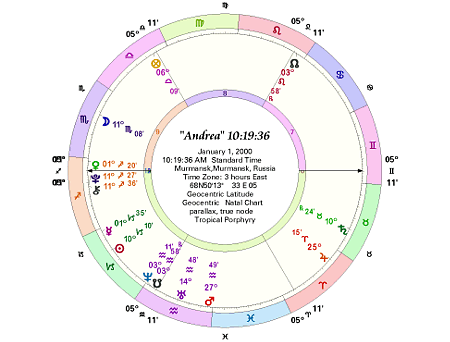

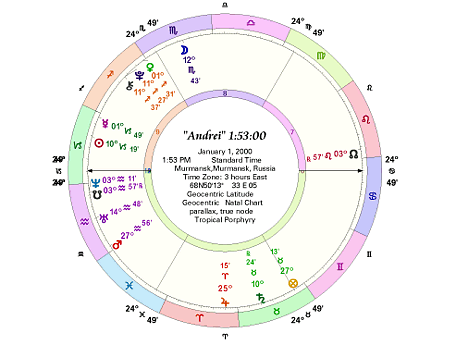
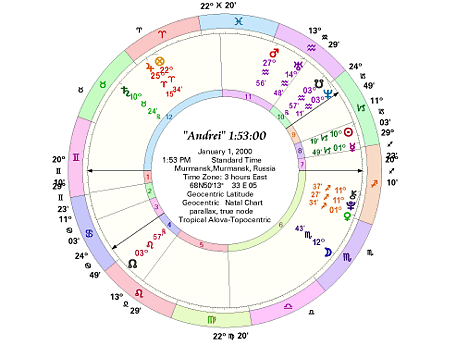
(Although you may have never heard of the Porphyry House System, your computer program is probably using it for Arctic latitudes if you select Placidus, Koch, or several others that are undefined at polar latitudes.)
For lower latitudes, there is no need to show new research on the validity and utility of this new “progressive” Topocentric House System because the house cusps are so close to Placidus on which such research has already been done. Here are some comparisons:
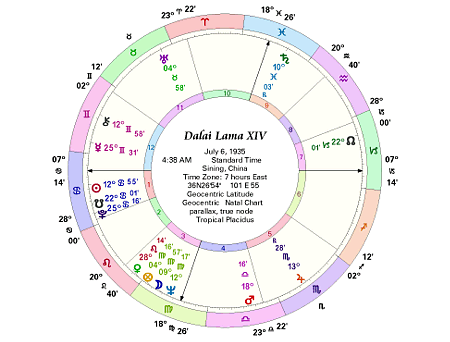
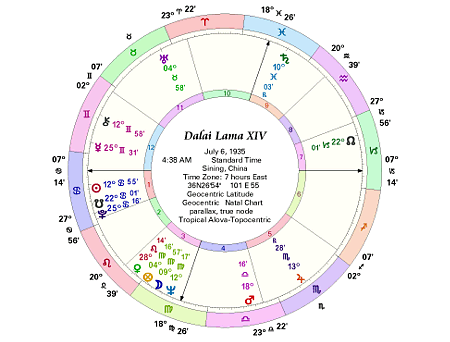
Princess Diana (53°N)
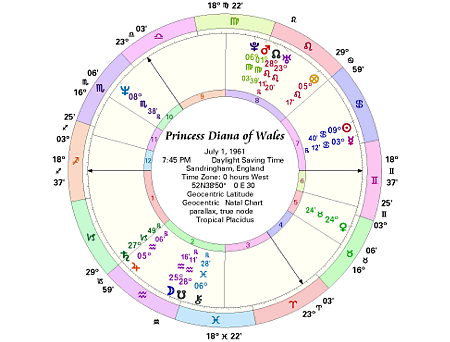
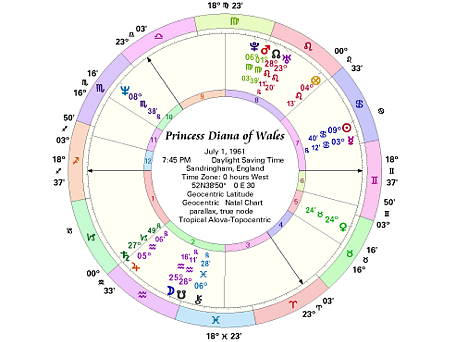
Notice how close the house cusps are— only a few minutes of arc in most cases. For Princess Diana born at 53°N, the maximum difference, for the cusp of the 2nd house, is only 1° 22'.
Ann-Margaret (64°N)
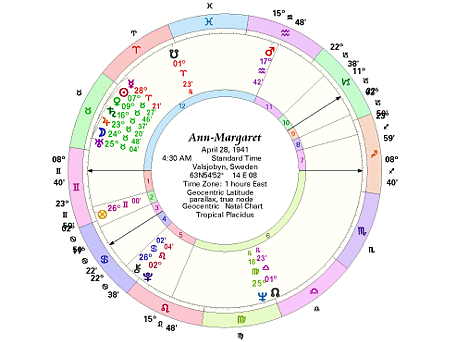
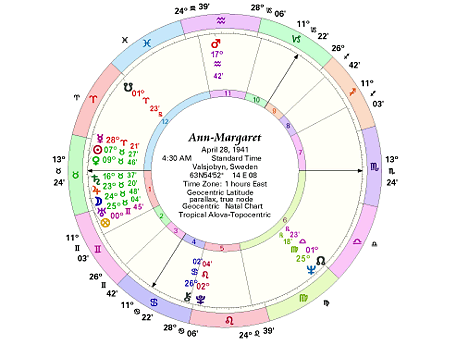
For Ann-Margaret, born only 2½° from to the Arctic Circle, the new “progressive” Topocentric Ascendant is quite close to Venus, Sun and Saturn, and in close trine to her Midheaven (which is unchanged). Astrologers can quickly recognize that this Ascendant makes more sense, considering her earthy,voluptuous sensuality. The traditional Ascendant lacks major aspects and places eight planets well into the 12th house, which is inconsistent with her prominent dancing career focusing on the physical body. However, her personality and career are very consistent with the new “progressive” Ascendant conjunct Sun, Venus, and Saturn, showing four planets, including Moon and Jupiter, in the first house.
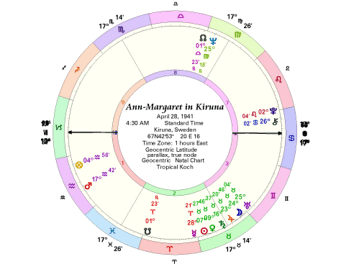
Had she been born further north in Kiruna, Sweden, Placidus, Koch and others could not even construct a chart that is readable.
With this new house system, you can now calculate charts for Arctic latitudes, at all times of day and year, and see horoscopes that you can actually interpret.
The proof is in the results! Try it out, and include a few horoscopes for events in arctic regions—which you can finally calculate rather than be left empty-handed.
The formula and technical details are included below so that all astrology programs can easily add this new house system. The adjustment is so simple that it requires only two lines of code for a program that already has Topocentric house system as an option.
The first test of a house system is natal or event interpretation. We can test and utilize predictive methods only after we have a house system that we can trust because a large number of astrologers find it to consistently yield accurate natal interpretations. And, of course, because it can be used for events anywhere on our beloved Earth.
Meanwhile, if you are approached by an oil executive for advice on when and where to drill for oil in Siberia, you can now take up the challenge!
How to Calculate Topocentric House Cusps
The method of calculating house cusps for Topocentric house system remains unchanged. The only difference in the new “progressive” method is that a new value of the “pole” of the Ascendant is used. The formula for the proposed modification, as represented by the “Proposed” curve on the above graph, is simple and straightforward:
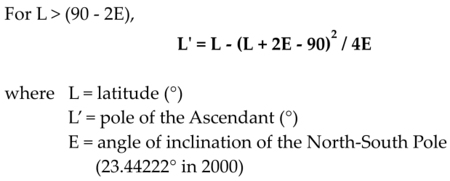
The following table indicates values of L and Lʹ from 0° to 90°, along with the corresponding Poles of the intermediate Topocentric houses. The pole is the latitude for calculating the Ascendant using a normal Table of Ascendants (such as Placidus). As usual, the Pole of the 11th and 3rd houses = arctan (1/3 tan Lʹ), and the Pole of 12th and 2nd houses = arctan (2/3 tan Lʹ).
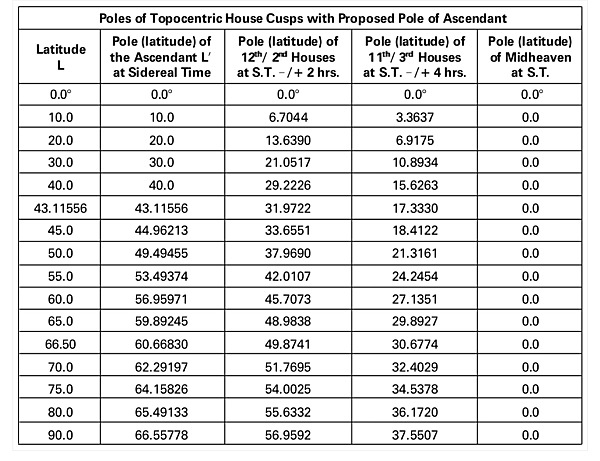
Intermediatecusps in the Topocentric House System are calculated from a normal Table ofHouses by simply finding the Ascendant at the pole, at the time listed for thehouse. For example, for a birth at Sidereal Time 3.0h at latitude 50°N, calculate the Midheaven and Ascendant for 3h,49.49455°N. Then the 11th house cusp is theAscendant at 23h, 21.316°N, the 12th cusp is the Ascendant at 1h,37.969°N, the 2nd cusp is the Ascendant at 5h, 37.969°N, and the 3rd cusp is the Ascendant at7h, 21.316°N. These calculations yield:

For an event at polar latitudes, simply follow the same procedure using the above table (or formulas). For a birth at 3h S.T. at latitude 70°N, the following values are obtained:

Data Requested: Now that there is a house system that can actually construct charts for polar latitudes, data is needed for research purposes. Anyone who might be able to help gather birth data is graciously invited to contact the author by e-mail listed below. Fluency in Russian would be especially valuable since Murmansk, Russia, should be a good source. Data for people who are alive and willing to answer questions is preferred. Data for birth twins, born anywhere, is also requested.
Theoretical NoteConstructing a house system for all latitudes that uses the traditional Ascendant and Midheaven, which have been found empirically to be significant, is not a simple matter.(6) The Topocentric House System is empirical, its geometrical theory somewhat unusual, so the present empirical proposal does not represent a serious theoretical divergence and may in fact strengthen the fundamental topocentric approach if it proves useful. Experiment is the ultimate test. The Topocentric House System works well, is one of the few for which polar horoscopes are possible, and its empirical success at lower latitudes inspired—nay, necessitated—the present work.
Notice that the formula proposed for the Topocentric Pole of the Ascendant would also work if the Earth were inclined at other angles. If the Earth’s inclination were 10°, the Pole of the Ascendant between 70° and 90° would go smoothly from 70° to 80°, and if the Earth’s inclination were 40°, the Pole of the Ascendant between 10° and 90° would go smoothly from 10° to 50°.
Day-for-a-year predictive techniques in any house system,including the common Solar progression, seem to be useful in some non-polarcases, but fail completely in other cases. Transits, on the other hand, arefound by both Western and traditional Indian astrologers to be always involvedin the timing of events, even though they are not in themselves sufficient forprediction. In fact, if any purely astrological or mathematical system weresufficient for prediction, then all events would be pre-determined, and such iscertainly not the case. When a House System is found that work for alllatitudes, then and only then can we test predictive techniquesinvolving its house cusps
References2. Wilhelm, Ivan, Charts in Arctic Regions of the Earth, http://hem.bredband.net/ivawil/program/polar/index.htm. This article shows with beautiful 3-dimensional pictures how the Ascendant has to jump 180°twice a day at polar latitudes (during winter and summer) because some sections of the Ecliptic do not intersect the Horizon. If one uses an alternate definition of the Midheaven so that it also jumps 180°at the same time as the Ascendant does, this results in horoscopes with the entire zodiac going clockwise for a portion of the day.
3. Alova, “Astro-Geometry,” ISAR International Astrologer, Aries 2010, posted on www.astrosoftware.com/Astro-Geometry.htm and www.astrowisdom.net/articles/astro-geometry.htm.
4. Polich, Wendel & A.P. Nelson Page, “The Topocentric System of Houses,” Spica, 1964, Vol. 3, No. 3, p. 1-10, posted on http://pollux1151.hypermart.net/topocentric.pdf.
5. Balasundaram, B. and A.R. Raichur, Universal Table of Houses, 2nd ed. (1997, Chennai: Krishnamurti Publications).
6. In Sirius 1.1, go to Settings/Other Settings/Astro Settings/Ayanam.Houses andcheck the box that says “Topocentric Houses calculated with “Alova”correction.” In Sirius 1.0 or Kepler 7, first make an empty file called“Topoalov” in your Sirius1 directory, open Sirius, and select the same optionsas above. The house system name will appear as “Alova-Topocentric” as in theabove wheels.
7. Charts made using Sirius 1.0, www.astrosoftware.com/sirius.htm.
8. Makransky, M J, Primary Directions: A Primer of Calculation (1988, Occidental, California: Dear Brutus Press; out of print, available as pdf download from www.dearbrutus.com/books/ –Books –Primary Directions).
Figure 2 Some Sections of the Ecliptic Cannot Rise on Some Days
Figure 3 Graph of Previous and Proposed Topocentric Pole of Ascendant vs. Latitude
Table 1 Poles of Topocentric House Cusps with Proposed Pole of Ascendant
Table 2 Topocentric and Placidus House Cusps with Proposed Pole of Ascendant for 3h, 50°N
Table 3 Topocentric House Cusps with Proposed Pole of Ascendant for 3h, 70°N